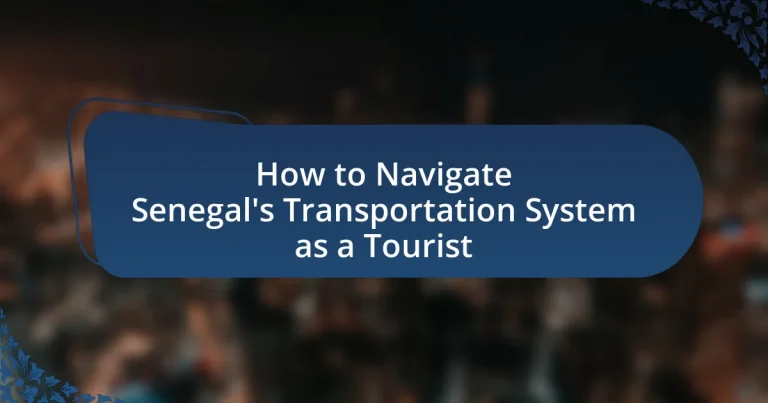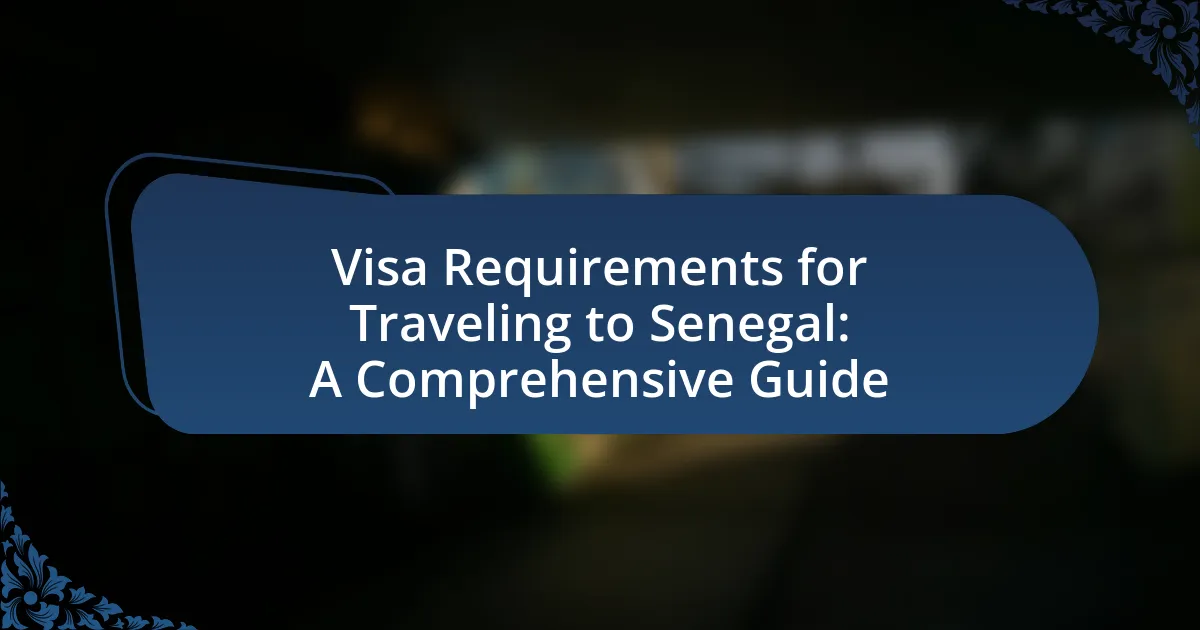Senegal’s transportation system for tourists encompasses various modes, including public buses, taxis, car rentals, and ferries, facilitating travel across the country. Public buses, particularly the “car rapides,” offer affordable options for both local and long-distance journeys, while taxis provide flexible travel with negotiated fares. Car rentals are available for those seeking independence, and ferries connect the mainland to popular islands. Tourists should be aware of safety considerations, potential language barriers, and common scams, as well as best practices for navigating the system effectively. Understanding these elements will enhance the overall travel experience in Senegal.
How does Senegal’s transportation system function for tourists?
Senegal’s transportation system for tourists primarily functions through a combination of public transport, taxis, and car rentals. Public transport includes buses and shared minibuses known as “car rapides,” which are affordable and connect major cities and tourist attractions. Taxis are widely available, with options for metered and negotiated fares, providing convenience for direct travel. Additionally, car rentals are accessible in urban areas, allowing tourists to explore at their own pace. The effectiveness of this system is supported by the country’s growing infrastructure and the increasing number of services catering specifically to tourists, enhancing mobility and accessibility throughout Senegal.
What are the main modes of transportation available in Senegal?
The main modes of transportation available in Senegal include buses, taxis, car rentals, and ferries. Buses are a popular and affordable option for both local and long-distance travel, with the Dakar Dem Dikk network serving the capital and surrounding areas. Taxis, including shared taxis known as “sept-place,” provide flexible travel options within cities. Car rentals are available for tourists seeking independence, while ferries operate between the mainland and islands like Gorée and Îles de la Madeleine, facilitating access to these destinations. These transportation options are essential for navigating Senegal efficiently.
How do taxis operate in Senegal?
Taxis in Senegal operate primarily as shared or private vehicles, with a significant presence of “car rapides,” which are colorful minibuses that follow set routes. Passengers can hail taxis on the street or find them at designated taxi stands, and fares are typically negotiated before the ride, as meters are rarely used. The car rapides serve as an affordable option for short distances, while private taxis offer more comfort and flexibility for longer trips. The system is informal, with drivers often relying on local knowledge for navigation, making it essential for tourists to communicate their destinations clearly.
What is the role of buses in Senegal’s transportation system?
Buses play a crucial role in Senegal’s transportation system by providing affordable and accessible public transit options for both locals and tourists. They connect major cities, towns, and rural areas, facilitating movement across the country. The bus network includes various services, such as long-distance intercity buses and local minibuses, which are essential for daily commuting and travel. According to the Senegalese Ministry of Transport, buses account for a significant portion of public transport, with thousands of passengers relying on them daily for economic and social activities.
How do car rentals work for tourists in Senegal?
Car rentals for tourists in Senegal typically involve selecting a rental agency, providing necessary documentation, and adhering to local driving regulations. Tourists can choose from various rental companies, including international brands and local agencies, which often require a valid driver’s license, passport, and a credit card for payment.
Most agencies offer a range of vehicles, from economy cars to SUVs, catering to different travel needs. It is essential for tourists to understand that driving in Senegal may differ from their home countries, with local traffic rules and road conditions varying significantly. Additionally, many rental companies provide optional services such as GPS navigation and insurance coverage to enhance the driving experience.
Tourists should also be aware that fuel stations may be limited in rural areas, making it crucial to plan refueling stops in advance. Overall, renting a car in Senegal allows tourists greater flexibility to explore the country at their own pace while navigating its unique transportation landscape.
What are the key considerations for tourists using public transportation?
Key considerations for tourists using public transportation include understanding the local transit system, safety, and cultural norms. Tourists should familiarize themselves with the schedules, routes, and types of available transportation, such as buses, taxis, and shared vehicles, to ensure efficient travel. Safety is paramount; tourists should remain vigilant about their belongings and avoid traveling alone at night. Additionally, being aware of local customs, such as how to interact with drivers and fellow passengers, can enhance the travel experience. For instance, in Senegal, it is common to greet drivers before boarding, which reflects local etiquette.
How safe is public transportation in Senegal for tourists?
Public transportation in Senegal is generally considered safe for tourists, although caution is advised. The country has a variety of transport options, including buses, taxis, and shared vehicles known as “car rapides.” While incidents of petty crime can occur, especially in crowded areas, the overall risk is manageable. According to the U.S. Department of State, tourists should remain vigilant, particularly in urban centers like Dakar, where theft can happen. Additionally, using reputable taxi services and avoiding travel at night can enhance safety.
What are the costs associated with using public transportation in Senegal?
The costs associated with using public transportation in Senegal vary depending on the mode of transport. For example, a typical bus fare ranges from 150 to 500 CFA francs, while a taxi ride within the city can cost between 1,000 and 3,000 CFA francs, depending on the distance. Additionally, the popular “car rapide” buses, which are a common form of public transport, charge fares around 200 CFA francs for short distances. These prices reflect the affordability of public transportation in Senegal, making it accessible for both locals and tourists.
What challenges might tourists face when navigating Senegal’s transportation system?
Tourists in Senegal may face challenges such as limited public transportation options, language barriers, and inconsistent schedules. The public transportation system primarily relies on shared taxis and buses, which can be infrequent and overcrowded, making it difficult for tourists to plan their journeys effectively. Additionally, many local drivers and transport staff may not speak English, complicating communication for non-French speakers. Furthermore, the schedules for public transport are often not strictly adhered to, leading to uncertainty in travel times. These factors can create a frustrating experience for tourists trying to navigate the transportation system in Senegal.
How can language barriers affect transportation experiences?
Language barriers can significantly hinder transportation experiences by causing misunderstandings and miscommunications between travelers and local transport providers. For instance, tourists may struggle to comprehend schedules, routes, or fare structures, leading to missed connections or incorrect destinations. A study by the World Bank indicates that effective communication is crucial in transportation systems, as it directly impacts user satisfaction and operational efficiency. In Senegal, where French and local languages dominate, tourists who do not speak these languages may face challenges in obtaining accurate information, resulting in frustration and delays during their travels.
What common phrases should tourists know for transportation in Senegal?
Tourists in Senegal should know phrases such as “Où est la gare?” (Where is the station?), “Combien ça coûte?” (How much does it cost?), and “Je voudrais un taxi” (I would like a taxi). These phrases facilitate communication with drivers and locals, making navigation easier. Knowing these expressions enhances the travel experience by allowing tourists to ask for directions, negotiate fares, and request transportation services effectively.
How can tourists overcome language challenges when using taxis or buses?
Tourists can overcome language challenges when using taxis or buses by utilizing translation apps, carrying written addresses in the local language, and learning basic phrases. Translation apps like Google Translate facilitate real-time communication, allowing tourists to input their destination and show it to the driver. Carrying a card with the destination written in the local language helps ensure clarity, especially in areas where English is not widely spoken. Additionally, learning essential phrases such as “Where is…?” or “Please take me to…” can enhance communication and improve the overall travel experience. These strategies are effective as they directly address the language barrier, enabling smoother interactions with local transportation services.
What are the common scams or issues tourists should be aware of?
Common scams tourists should be aware of in Senegal include overcharging by taxi drivers, fake tour guides, and pickpocketing in crowded areas. Taxi drivers often do not use meters, leading to inflated fares; tourists should agree on a price before starting their journey. Additionally, some individuals may pose as official tour guides, offering services without proper credentials, which can result in subpar experiences or scams. Pickpocketing is prevalent in busy markets and public transport, so tourists should remain vigilant and keep their belongings secure. According to the U.S. Department of State, being aware of these issues can significantly enhance safety and enjoyment while traveling.
How can tourists identify and avoid taxi scams in Senegal?
Tourists can identify and avoid taxi scams in Senegal by using registered taxis, agreeing on fares before starting the journey, and being cautious of unlicensed drivers. Registered taxis in Senegal typically have a taxi sign on the roof and a meter; tourists should ensure the meter is used or negotiate a fare upfront to prevent overcharging. Additionally, tourists should avoid accepting rides from individuals who approach them directly, as these are often unlicensed drivers looking to exploit visitors. According to the Senegalese Ministry of Tourism, using official taxi services significantly reduces the risk of scams.
What should tourists do if they encounter problems with transportation services?
Tourists should immediately contact the transportation service provider to report any issues encountered. This action allows for prompt resolution, as most providers have customer service hotlines or support staff available. Additionally, tourists can seek assistance from local authorities or nearby businesses, as they often have experience dealing with transportation problems and can offer guidance. It is also advisable for tourists to document the issue, including taking photos or noting details, which can be useful for any claims or complaints.
What tips can help tourists navigate Senegal’s transportation system effectively?
To navigate Senegal’s transportation system effectively, tourists should familiarize themselves with the various modes of transport available, including taxis, buses, and car rentals. Taxis are widely available and can be hailed on the street or booked via mobile apps, but it is advisable to agree on a fare before starting the journey to avoid misunderstandings. Public buses, known as “car rapides,” offer an affordable way to travel but can be crowded and may not adhere to strict schedules, so understanding the routes in advance is beneficial. Additionally, renting a car can provide flexibility, but tourists should be aware of local driving customs and road conditions. Knowing basic French phrases can also enhance communication with drivers and locals, facilitating smoother travel experiences.
How can tourists plan their transportation routes in advance?
Tourists can plan their transportation routes in advance by utilizing online mapping services and local transportation apps. These tools provide real-time information on routes, schedules, and available modes of transport, such as buses, taxis, and ride-sharing services. For instance, Google Maps and local apps like Yango offer detailed navigation options and estimated travel times, allowing tourists to optimize their journeys. Additionally, researching public transport options and schedules ahead of time can help tourists avoid delays and ensure a smoother travel experience.
What resources are available for tourists to understand transportation options?
Tourists can utilize various resources to understand transportation options in Senegal, including official tourism websites, mobile applications, and local guides. Official tourism websites provide comprehensive information on public transport systems, including buses and taxis, while mobile applications like Google Maps and local transport apps offer real-time navigation and route planning. Additionally, local guides can offer insights into the best transportation methods for specific destinations, enhancing the overall travel experience. These resources collectively ensure that tourists have access to accurate and practical information for navigating Senegal’s transportation system effectively.
How can mobile apps assist tourists in navigating Senegal’s transportation system?
Mobile apps can assist tourists in navigating Senegal’s transportation system by providing real-time information on routes, schedules, and available transport options. For instance, apps like Google Maps and local alternatives offer detailed maps and directions for buses, taxis, and ride-sharing services, enabling tourists to plan their journeys efficiently. Additionally, these apps often include user reviews and ratings, which help tourists choose reliable transportation services. Furthermore, features such as language translation and offline access enhance usability for non-French speakers, making it easier to communicate and navigate the system.
What are the best practices for using transportation in Senegal?
The best practices for using transportation in Senegal include utilizing public transport options like buses and taxis, ensuring to negotiate fares beforehand, and being aware of local traffic regulations. Public buses, known as “car rapides,” are cost-effective but can be crowded; therefore, travelers should plan their routes in advance. Taxis are widely available, but it is advisable to confirm the fare before starting the journey to avoid misunderstandings. Additionally, using ride-hailing apps can provide a safer and more reliable alternative. Understanding that traffic can be unpredictable, travelers should allow extra time for their journeys. These practices enhance safety and efficiency while navigating Senegal’s transportation system.
How should tourists handle payments for transportation services?
Tourists should handle payments for transportation services in Senegal primarily through cash transactions, as many local services may not accept credit cards. It is advisable for tourists to carry local currency, the West African CFA franc, to ensure they can pay for taxis, buses, and other forms of transport. Additionally, using mobile payment options like Orange Money is becoming increasingly popular and accepted in urban areas, providing a convenient alternative to cash. Tourists should confirm the fare before starting a journey to avoid misunderstandings, as many drivers may not use meters.
What safety precautions should tourists take while using public transport in Senegal?
Tourists in Senegal should remain vigilant and take specific safety precautions while using public transport. It is advisable to avoid displaying valuables, such as expensive jewelry or electronics, to minimize the risk of theft. Additionally, tourists should use reputable transport services, such as recognized taxi companies or ride-hailing apps, to ensure safer travel experiences.
Travelers should also be cautious when using crowded buses or shared taxis, as these can be hotspots for pickpockets. Keeping personal belongings secured and close to the body can help prevent theft. Furthermore, it is recommended to travel during daylight hours when visibility is better and the risk of encountering unsafe situations is lower.
Lastly, staying informed about local customs and potential scams can enhance safety. Engaging with local residents or fellow travelers for advice can provide valuable insights into safe transport practices in Senegal.





